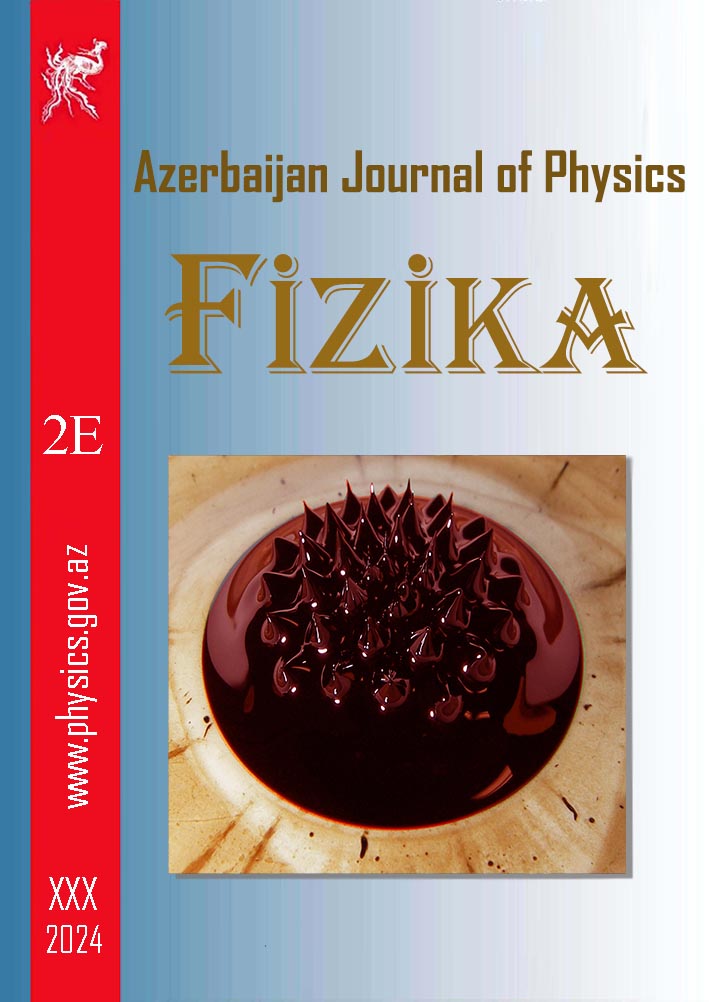ABSTRACT
The influence of post-deposition annealing at 600 –900°C on optical properties of ZnO films co-doped with Erbium (Er) ions has been investigated by UV-V is,
photoluminescence (PL) and photoluminescence excitation (PLE) methods. Er-doped ZnO (ZnO:Er) thin films were grown on fused quartz and p-Si substrates at 25ºC by
radio-frequency magnetron sputtering method. In accordance with the previously reported literature studies, post-growth annealing was required to activate the optical
emission originated from the intra-shell transitions of the Er atoms. Transmission spectra of as-deposited Er-doped ZnO films contain a wide absorption band in the
near-infrared region. It was found that an increase in the annealing temperature leads to an increase in the photoluminescence intensity in the spectral range of 1.5-3.0eV.
PLE spectra of ZnO:Er films contain a band with a maximum at ~3.40eV which corresponds to the band gap energy of ZnO.
Keywords: ZnO:Er films, magnetron sputtering, optical properstes, PL spectra.
PACS: 61.10.Kw, 68.37.-d, 78.20.-e, 78.30.Fs
Received: 02.02.2022
AUTHORS & AFFILIATIONS
State Scientific and Production Association “Scientific-Practical Materials Research Centre of the National Academy of Sciences of Belarus”, 220072,
Minsk, P. Brovka Str. 19, Republic of Belarus
E-mail:
|
REFERENCIES
[1] S. Hufner. Optical Spectra of Transparent Rare Earths Compounds. Academic Press, New York, San Francisco, London, 1978, p.237.
[2] A.J. Kenyon. Prog. Quantum Electron. 2002, vol.26, pp.225–284.
[3] P.C. de Sousa Filho, J.F. Limaa, O.A. Serra, J. Braz. Chem. Soc., 2015, vol.26 (12), pp.2471-2495.
[4] V.A. Coleman, A. Victoria, C. Jagadish. Basic Properties and Applications of ZnO, Zinc Oxide Bulk, Thin Films and Nanostructures. Elsevier Science Ltd, Amsterdam, 2006, p.589.
[5] Y.S. Park, C.W. Litton, T.C. Collins, D.C. Reynolds. Phys. Rev., 1966, vol.143, pp.512−519.
[6] A. Polman. Journal of Applied Physics, 1997, vol.82, pp.1–39.
[7] H. Akazawa, H. Shinojima. Mater. Sci. Eng. B., 2014, vol.189, pp.38–44.
[8] V. Kumar, O.M. Ntwaeaborwa, T. Soga, V. Dutta, H.C. Swart. ACS Photonics, 2017, vol.4, pp.2613−2637.
[9] Y.K. Mishra, G. Modi, V. Cretu, V. Postica, O. Lupan, T. Reimer, I. Paulowicz, R. Adelung. ACS Appl. Mater. Interfaces, 2015, vol.7, pp.14303–14316.
[10] Z.L. Wang. Journal of Physics: Condensed Matter, 2004, vol.16, pp.R829–R858.
[11] V. Malyutina-Bronskaya, A. Semchenko, V. Sidsky, V. Fedorov, V. Saladukha, A. Perets. Proceedings of the IEEE 7th International Conference on Nanomaterials: Applications and Properties, 2017, pp.02NTF23-1-02NTF23-3.
[12] N.H. Nickel, E. Terukov. Zinc Oxide - A Material for Micro - and Optoelectronic Applications, Springer, Netherlands, 2005, p.240.
[13] J.I. Pankove. Optical Processes in Semiconductors, Prentice-Hall, Englewood Cliffs, New Jersey, 1971, p.422.
[14] A.J. Kenyon. Prog. Quantum Electron, 2002, vol.26, pp.225–284.
[15] T. Schmidt, G. Muller, L. Spanhel, K. Kerkel, A. Forchel. Chem. Mater., 1998, vol.10, pp.65−71.
[16] Juan Wang, M.J. Zhou, S.K. Hark, D. Tang, M.W. Chu, C.H. Chen. Appl. Phys. Lett., 2006, vol.89, pp.221917.
[17] M. Ishii, S. Komuro, T. Morikawa, Y. Aoyagi. J. Appl. Phys., 2001, vol.89, pp.3679-3684.
|
